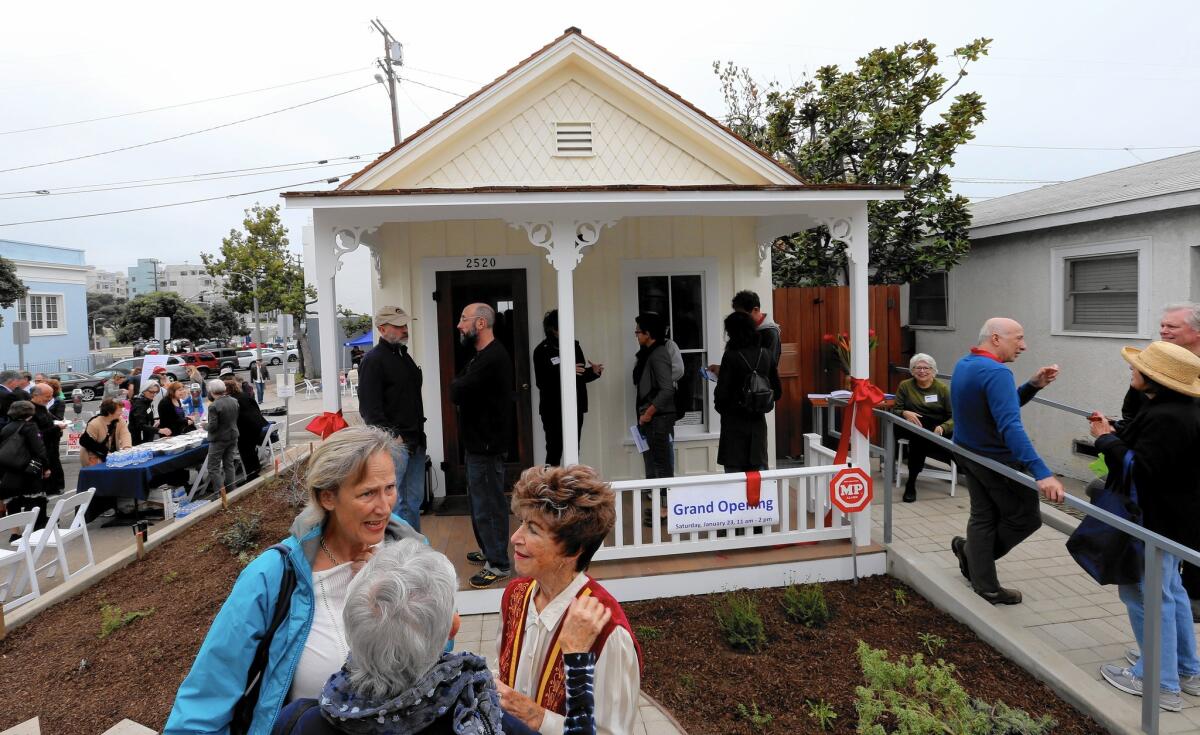Santa Monica’s last unadulterated ‘shotgun’ house serves as a lesson in preservation

Santa Monica residents gather at a “shotgun” house that had been slated for demolition but which is now the Santa Monica Conservancy’s Preservation Resource Center.
- Share via
It’s just a little slip of a house, three tiny rooms in a row.
But when its narrow front door opened on Saturday, people lined up for a chance to get in.
What is believed to be Santa Monica’s last unadulterated “shotgun” house — one straight, hallway-less shot from front door to back — had been through so much to reach what amounted to this moment of rebirth.
Its life had been threatened in the late 1990s, when its owner filed for a demolition permit. A neighborhood church and community organization had hustled to win it city landmark status.
In 2002, even though it had been landmarked, the city said it still could be torn down as long as it was properly documented first. A new owner had begun demolition — tearing off its back room, tossing most of its windows into a dumpster — when preservationists with the help of the city rescued it by moving it and then moving it again and again.
From 2002 to 2005, the little house sat in storage next to cars and planes at Santa Monica Airport. In 2005, when ground was broken to turn that storage spot into a park, the house was moved again to a city storage yard. In 2014, after its protectors spent years trying to find it a new home, it was put on a flatbed truck and moved to where it sits now, at 2520 2nd St.
Saturday the house now owned by the city and located on city-owned land began its new life as the nonprofit Santa Monica Conservancy’s Preservation Resource Center.
Freshly painted a pale buttery yellow with white trim, it is a place that people will be able to visit to learn about their local history and about what they can do to keep it alive.
On Saturday, giant scissors cut through a thick red ribbon on the small front porch. A bluegrass band played. Children bit into rainbow-sprinkled cupcakes.
Some volunteer docents led free walking tours of the surrounding neighborhood. Others handed out pamphlets describing the shotgun house’s past and future.
“Small houses can tell big stories,” read the apt white words on the pamphlet’s blue cover.
The shotgun house’s Ocean Park neighborhood had once been full of such modest dwellings. It was a working-class place — home to carpenters and painters and people who washed other people’s laundry.
But that kind of history most often is erased over time, as little houses make way for bigger ones. Ordinary people often don’t chronicle their lives — and when they leave, their stories do too.
In its early days, the shotgun house sat two blocks away — at 2712 2nd St. That’s probably where it started out life, probably in the 1890s — though it may have been moved to 2nd Street from the nearby beachfront when the value of that oceanside property went up. Again, it’s hard to trace this kind of modest history.
Nina Fresco, a conservancy board member, has written a short book about the house that people can flip through when they visit. She said she found the first known record of the house’s existence on a 1902 Sanborn Fire Insurance Map.
On display in the house is a model she built — complete with diminutive period furniture and stamp-size paintings on the walls — to give visitors a sense of how it probably first looked inside.
The conservancy, which was founded in 2002, raised money to rehabilitate the house — preserving as much as possible while making small adjustments so that the space could be put to useful purpose, said president Carol Lemlein.
A wall between the first and second rooms, for example, folds back to create one bigger room for workshops, meetings and even elementary school classes. The conservancy is collaborating with city educators to create a curriculum to teach local history to Santa Monica third-graders.
The house itself is meant to be a lesson in preservation, said conservancy board member Mario Fonda-Bonardi, who was the architect in charge of the rehabilitation project.
A block away, he pointed out another former shotgun house that had been added on to so much that few people would recognize its origins.
See more of our top stories on Facebook >>
Even as he changed minor details inside the conservancy’s shotgun house, he said, he left plenty of clues about its past.
Without insulation and sheetrock placed over the original redwood walls, for instance, the center would have been too cold in winter. But a bit of the new covering was cut away in the front room so that visitors could see what the redwood looked like.
On the beadboard ceiling of the middle room, Fonda-Bonardi chose not to paint over the spots where two light fixtures had been, he said, because they let you see that the room at one point in its past probably had been divided into two.
Life moves on, he said.
“But you always want to save your best — your best pair of shoes, your best photograph. We saved a pure example of a shotgun house.”
ALSO
300-year-old cello is found unharmed inside stolen car
Search underway for 3 inmates who escaped Orange County jail
Homeless man charged in Burbank hatchet threat has murder and assault convictions
More to Read
Sign up for Essential California
The most important California stories and recommendations in your inbox every morning.
You may occasionally receive promotional content from the Los Angeles Times.











